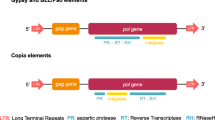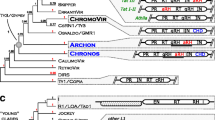Abstract.
Gypsy LTR-retrotransposons have been identified in the genomes of many organisms, but only a small number of vertebrate examples have been reported to date. Here we show that members of this family are likely to be widespread in many vertebrate classes with the possible exceptions of mammals and birds. Phylogenetic analyses demonstrate that although there are several distinct lineages of vertebrate gypsy LTR-retrotransposons, the majority clusters into one monophyletic clade. Groups of fungal, plant, and insect elements were also observed, suggesting horizontal transfer between phyla may be infrequent. However, in contrast to this, there was little evidence to support sister relationships between elements derived from vertebrate and insect hosts. In fact, the majority of the vertebrate elements appeared to be most closely related to a group of gypsy LTR-retrotransposons present within fungi. This implies either that at least one horizontal transmission between these two phyla has occurred previously or that a gypsy LTR-retrotransposon lineage has been lost from insect taxa.
Similar content being viewed by others
Author information
Authors and Affiliations
Additional information
Received: 22 December 1998 / Accepted: 6 April 1999
Rights and permissions
About this article
Cite this article
Miller, K., Lynch, C., Martin, J. et al. Identification of Multiple Gypsy LTR-Retrotransposon Lineages in Vertebrate Genomes. J Mol Evol 49, 358–366 (1999). https://doi.org/10.1007/PL00006559
Issue Date:
DOI: https://doi.org/10.1007/PL00006559




